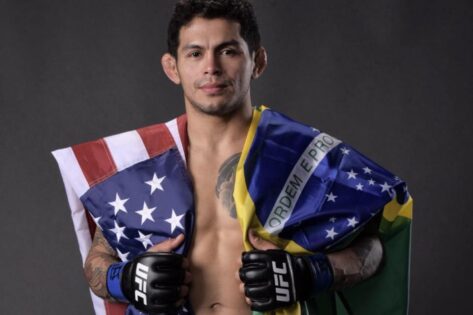“I don’t have that much time left in my career. I don’t want to think about it, but I could be approaching retirement,” Carlos Diego Ferreira, who turned 40 this January, told Sherdog when discussing his future in the UFC. Despite these contemplations, the lightweight contender shows no signs of slowing down, as evidenced by his upcoming fight against King Green.
The two are set to clash on the preliminary card at UFC 319, scheduled for August 16, 2025, at the United Center in Chicago, Illinois. Even before his loss to Grant Dawson, Carlos Diego Ferreira expressed frustration about his fight frequency. “The UFC hasn’t been booking me as frequently as I wish.” At 40, however, his final bout may not be far off. Before he hangs up the gloves, here’s everything you need to know about his journey and background.
Is Carlos Diego Ferreira from Brazil? Ethnicity and nationality
The 40-year-old was born and raised in Careiro da Várzea, Amazonas, Brazil, and he often proudly represents his country through his mixed martial arts career. Known for his exceptional grappling skills, Ferreira is the embodiment of the Brazilian fighting style, a region of the world that has dominated mixed martial arts for decades. Ferreira demonstrated elite grappling credentials early on — he earned bronze in 2008 and silver in the 2009 IBJJF World No-Gi Championship, underscoring his technical prowess before transitioning to MMA.
Turning to his ethnicity, thanks to his Brazilian roots and the country’s rich cultural melting pot, Ferreira likely has a diverse mix of European, Indigenous, African, and other ancestries. Although specific details aren’t available about his religious beliefs, nor has he spoken about it, Catholicism is the predominant religion followed in Brazil.
He relocated to the United States a decade ago to pursue a career in Brazilian Jiu-Jitsu. “I really went to the United States to compete and become world champion in jiu-jitsu,” he told MMA Fighting. His motivations to fight? “I wanted to fight every two or three months to make some money and send it to my family.”
More about Carlos Diego Ferreira’s background and early life
Growing up in a town near the Amazon River in Brazil, Ferreira was deeply connected with the natural beauty of the region before his family moved to Manaus when he was eight. It was there that he started playing soccer and practicing Capoeira, two athletic disciplines that would shape his early years. Just two years later, he found his real passion—Brazilian Jiu-Jitsu. Under the mentorship of his trainer Faustino Pina Martins Neto, he earned his blackbelt by age 18. Ferreira demonstrated elite grappling credentials early on. He earned bronze in 2008 and silver in the 2009 IBJJF World No-Gi Championship, underscoring his technical prowess before transitioning to MMA.
He often looked up to Ronaldo ‘Jacare’ Souza, dreaming of becoming a BJJ world champion. Ferreira actually moved to the United States in 2008 to pursue Brazilian Jiu-Jitsu, later basing himself in Pharr, Texas, and spent well over 17 years building his life and coaching roots in the U.S.
Before fully committing to MMA, the father of five worked as a mattress store salesperson, all while teaching Jiu-Jitsu to others. His path changed when a friend offered him $300 for a fight, which he gladly accepted to support his family back in Manaus. That night was his first in pursuit of becoming a professional fighter.
In MMA, Ferreira remains a dual-threat, capable of knockout power or methodical grappling control. His ability to fluidly switch between striking range and ground dominance gives him a tactical edge, particularly against a fighter like Bobby Green, known for unpredictable timing and pace variations.
Although Carlos Diego Ferreira never won a title in the UFC, his background and journey from Manaus to the UFC are a testament to his legacy. His career might be on its last leg, but his lifelong obsession with BJJ has uplifted the sport immensely. Do you think he can win on August 16th?
The post Where Is Carlos Diego Ferreira From? Nationality, Ethnicity, and Religion appeared first on EssentiallySports.
